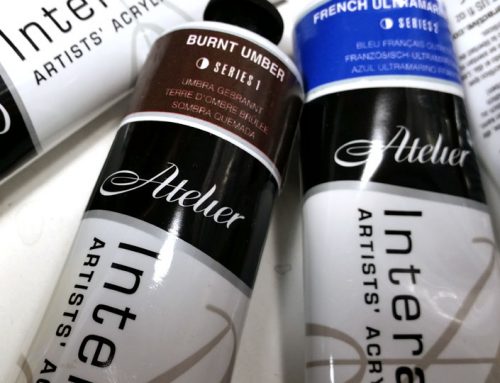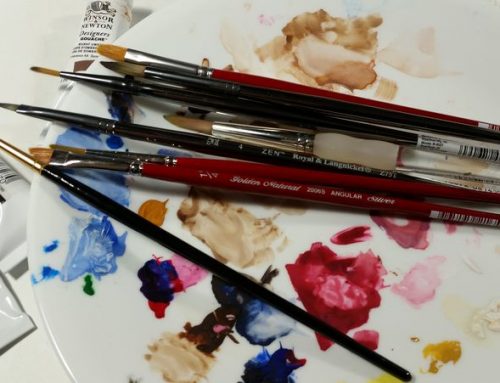An on-going project of mine is to construct an inexpensive rig so I can use a DSLR with a decent lens to photograph artwork with high resolution. Since this will require “stitching” a grid of photos together, it’s ideal if the distortion is kept to a minimum. Of course there is going to be some lens distortion, that’s unavoidable. But if tilt/yaw distortion can be minimized, that means fewer new digital artifacts are likely to be introduced. To that end, it was clear that I needed some sort of tool to ensure that the camera’s film plane was parallel to the artwork. I needed a reticle set.
Prep
A search of the web yielded nothing helpful. There are some calibration tools for rifle scopes and some for microscopes, but I was unable to find anything that was: 1) small; 2) affordable (i.e. cheap); 3) and would allow me to set up a variety of cameras/lenses to align on. I discovered instead that a few others over the years had asked for such a device and were largely dissed for wanting a tool when Photoshop would do just as well. Clearly the naysayers didn’t understand the problem. I’d have to design my own.
My conceptual starting point came from the alignment targets used by a variety of spacecraft for docking. They are fairly simple: a stick perpendicular to a target; if you keep the tip of the stick in the middle of the target, then you are lined up. Easy-peasy. Well, easy at the scale of feet and meters, not so much with inch and centimeter. My margin of error was going to be very small. So I looked instead at the Apollo spacecraft. They had reticles all over the place to ensure that an astronaut was aligned correctly with their viewport/instruments. If I could take something like a 10x loupe and put in crosshairs, that might be the solution.
In lieu of sacrificing a loupe, I instead used one of the 1oz plastic sample cups I have to temporarily store paints. The translucent body would allow light in, it was compact (about the size of a loupe), and I have thousands of them to experiment with. Next step: the reticles. At first I opted for simple crosshairs, but testing showed that to be problematic. I opted instead for dot-in-circle (dot on the base, circle for the alignment), which I printed out onto transparency film. But that left one last problem: perpendicularity.
I needed a good way to position my targets so that when the dot was centered in the circle, that meant that they were perpendicular to whatever the tool was positioned upon. Of course my first thought was lasers, but I don’t happen to have any working laser pointers in house to experiment with. I almost settled on using a series of right-triangles until it finally occurred to me that the simplest solution was one that builders have been using for millennia: the plumb bob. I’d use Earth’s gravity to establish perpendicularity to a base that I would level using, as you might well suppose, levels.
Assembly
I employed my main tripod as the armature on which I mounted the plumb bob. It has a cranked center column that allowed for raising and lowering the bob without risking misalignment.
Step 1: I cut out the center portion of the 1oz cup’s closed end to allow for easy viewing.
Step 2: I cut out and glued the base crosshairs onto the wide end of the cup. I eye-balled the alignment as the crosshairs being centered on the cup itself wasn’t terribly crucial for this to work.
Step 3: I set down a target centered on the plumb bob’s point and taped it to the base.
Step 4: I centered the target on the cup’s base to the target and taped it down.
Step 5: I cut out the upper crosshairs.
Step 6: I ringed the top of the cup with glue and lightly placed the crosshairs onto it. Before the glue could set, I lowered the plumb bob so I could aligned the center of the ring to the point of the bob. I then pressed down on the target to firmly set it in the glue.
Testing
As my prototypes proved, it’s not easy to get everything just so. My goal was for the final tool to be no more than ±0.5° out of perpendicularity — though I’d probably accept ±1.0º. (My best prototype was at 2.3º)
The first test was on the assembly table. I reset the paper target, aligned to the bob. I placed the new tool and checked the bob to see if it centered on the top circle. It seemed to.
The next tests were photographic. One with the camera about 1 meter from the target to calculate how far from ideal the center of the target was. Another with the target on graph paper to test parallax errors both when the camera was aligned and again when it was ever-so-slightly misaligned.
Based on these camera tests, and a wee bit of the maths, I tallied an error from perpendicularity of 0.006º(!) from three measurements. Given my crude equipment, I’ll take it. The parallax test showed no distortion with an aligned target, and noticeable distortion, in the direction you’d expect, when the target was off by about 1º.
Unless I find something better, I’m counting this as a successful ad hoc DIY build for an apparently esoteric device. Now on to the other contraptions I still have to develop for the project.












